The Intel 750 series is a high performance SSD with NVM Express technology for use in workstations and client PC storage devices. It is designed for improved multi-core platform performance, low latency and Quality of Service. Through the use of its coupled PCIe and NVMe technology, it minimizes idle processor time while delivering a significant improvement in compute power. The 750 series comes in both 2.5” (which uses the SFF-8639 connector), 15mm Z-height, and Add-in Card (AIC) models in order to maximize its usability for specialized environments. Although there are limited use cases for the NVMe 2.5″ form factor at the moment, there are systems coming out for client use that support it as the next generation of high performance storage where PCIe cards may be limited by footprint.
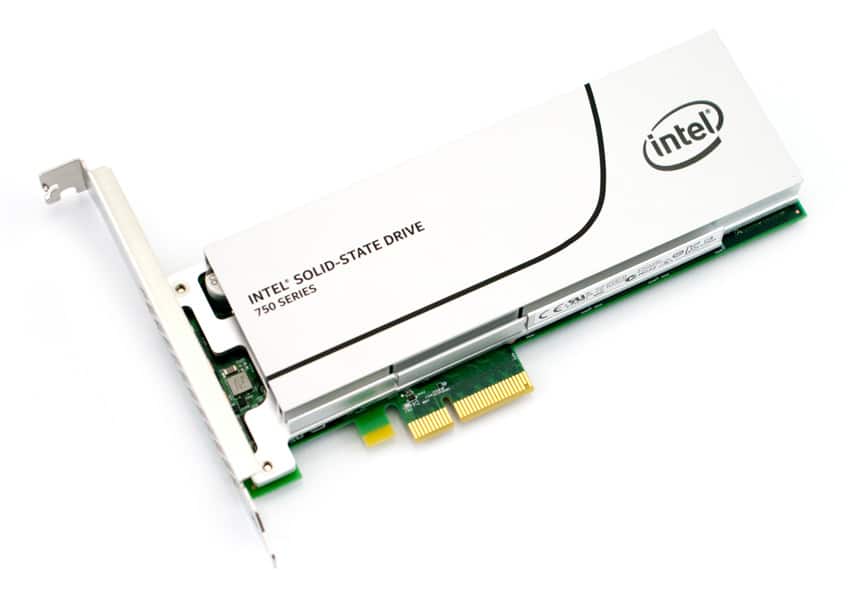
The Intel 750 supports PCI 3.0. Though more consumerized than previously released Intel P3700, the 750 Series is still a seriously fast SSD. This allows the drive to cater towards additional demographics like hardcore gamers and media professionals/enthusiasts, both of whom will also appreciate this new drive’s raw power. Additionally, the 750 can be used inside a desktop for SQL testing or development.
As far as the specifics of its performance, Intel indicates that this is their highest performing client SSD for client PC storage and workstations. As such, they are quoting some pretty serious numbers with up to 440,000 IOPS for random 4K reads and 230,000 IOPS for writes (400GB model). As for sequential speeds, Intel anticipates the 1.2TB unit to boast a blistering 2,400MB/s read and 1,200MB write, with the 400GB models trailing close behind.
The Intel 750 Series of SSDs comes in capacities of 400GB and 1.2TB, both of which are backed by a 5-year warranty. We will be looking at the 1.2TB AIC model.
Intel 750 Series Specifications:
- Capacities:
- 400GB
- 1.2TB
- 20nm MLC NAND
- Form Factors:
- 2.5”
- 15mm Z-height
- 8639-compatible connector
- Add-in Card:
- Half Height, Half Length
- Single slot x4 connector
- 2.5”
- Interface: PCIe Gen3 x4
- Performance:
- Sequential read: Up to 2400MB/s
- Sequential write: 1200MB/s
- 4K Random Read: Up to 440K
- 4K Random Write: Up to 290K
- Average sequential latency: 20µs read and write (TYP)
- Reliability:
- UBER: 1 sector per 1016bits read
- MTBF: 1.2 million hours
- Endurance: 70GB writes/day, up to 219 TBW
- Temperature:
- Operating:
- AIC: 0 to 55°C
- 2.5”: 0 to 70°C
- Non-operating: -55 to 95°C
- Operating:
- Operating System Support:
- Windows 7 (64-bit)
- Windows 8 (64-bit)
- Windows 8.1 (64-bit)
- UEFI 2.3.1 or later
Design and Build
The Intel 750 Series SSD has an HHHL form factor, and is equipped with a slick-looking metal cover used for branding and heat dispersion. This design allows for a fairly good thermal SSD environment, which is vital for increasing its lifespan since SSDs in PCIe slots do not receive nearly as much airflow as other form factors. When handled, the Intel 750 is a very rugged feeling device with a firmly placed cover.
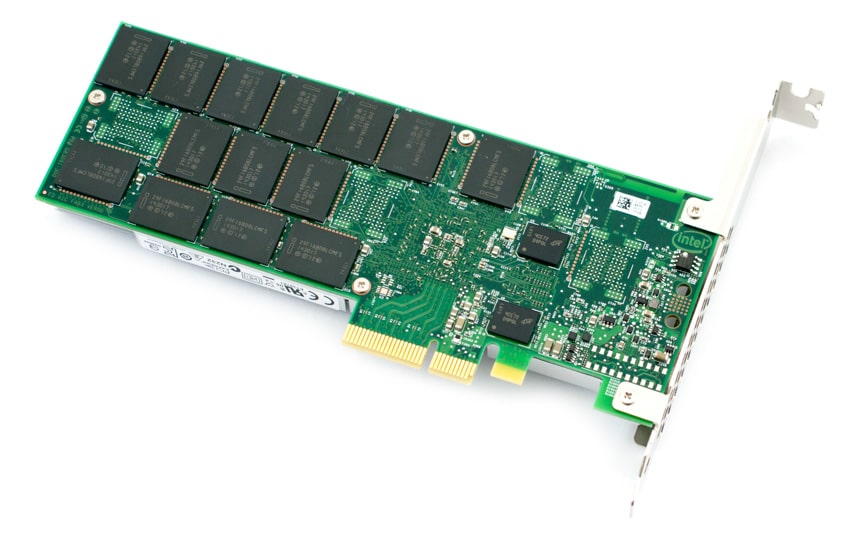
The metal enclosure is secured on the card with two screws on the back. Removing the front enclosure reveals Intel’s densely packed 20nm MLC NAND Flash Memory.
The Intel 750 uses the 4x PCIe Gen 3 connector and is equipped with a power cord to connect to standard ATX PSUs. The Intel 750 uses SFF-8639 PCIe connection to a 2.5” SSD and SFF-8643 for PCIe connection to the motherboard.
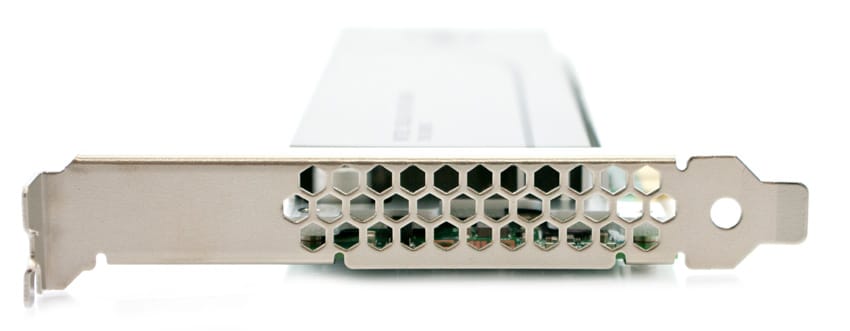
Testing Background and Comparables
We publish an inventory of our lab environment, an overview of the lab’s networking capabilities, and other details about our testing protocols so that administrators and those responsible for equipment acquisition can fairly gauge the conditions under which we have achieved the published results. None of our reviews are paid for or overseen by the manufacturer of equipment we are testing.
For our application performance analysis we will be comparing the Intel 750 to the Intel P3700 800GB both tested in our Lenovo ThinkServer RD630 running Windows Server 2012.
StorageReview’s Microsoft SQL Server OLTP testing protocol employs the current draft of the Transaction Processing Performance Council’s Benchmark C (TPC-C), an online transaction processing benchmark that simulates the activities found in complex application environments. The TPC-C benchmark comes closer than synthetic performance benchmarks to gauging the performance strengths and bottlenecks of storage infrastructure in database environments. Our SQL Server protocol uses a 685GB (3,000 scale) SQL Server database and measures the transactional performance and latency under a load of 30,000 virtual users.
In the 30k virtual users SQL Server test, we measured an average latency of 10ms for the 750 vs. 15ms for the P3700. Although the latency was only half as fast, the 750 showed improvement in the TPS benchmark with 6,311.93 TPS vs. 6,303.72 TPS by the P3700.


Consumer Synthetic Workload Analysis
All consumer SSD benchmarks are conducted with the mid-range StorageReview Consumer Testing Platform. The comparables used for the review below include:
- Intel SSD 730 (480GB, Intel PC29AS21CA0 controller, 20nm Intel MLC NAND, SATA)
- HP Z Turbo Drive (512GB, MLC NAND, PCIe)
- Dell Precision Tower 7810 (1.6TB, 20nm Intel MLC NAND, PCIe)
All IOMeter figures are represented as binary figures for MB/s speeds.
During our first test, which measures 2MB sequential performance, the 750 topped its competition in read with a speed of 1,852.97MB/s. However, it fell behind both the P3700 and the HP Z Turbo (configured in RAID0) in write with a speed of 1,238.26MB/s.
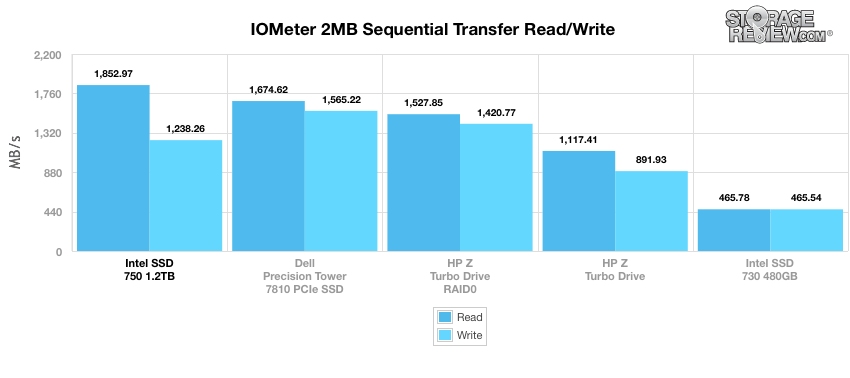
In our 2MB random transfer performance test, the 750 again came out on top in read performance with 1,668.49MB/s and managed to climb into second place behind the HP Z Turbo RAID0 in write speeds with 1,238.97MB/s.
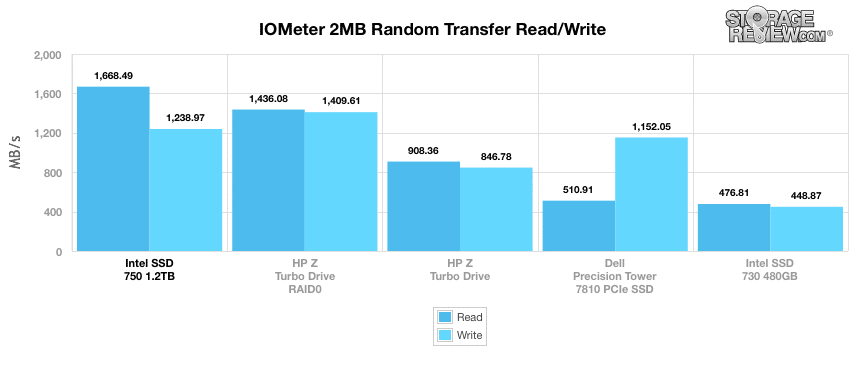
When switching to smaller 4K random transfers, the 750 flipped around and dominated in write performance with 215.99MB/s (almost twice as high as the next closest). It came in second in read with 33.91MB/s.
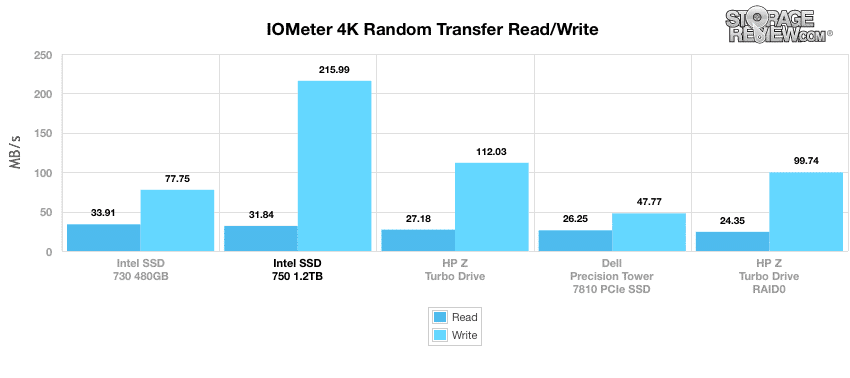
In our next test, we look at 4K Random Transfers IOPS. We saw similar results to our 4k random transfers in that the 750 blew away the other drives with a write performance of 55,292.31 IOPS and again came in second behind the 730 with a read performance of 8,150.27 IOPS.
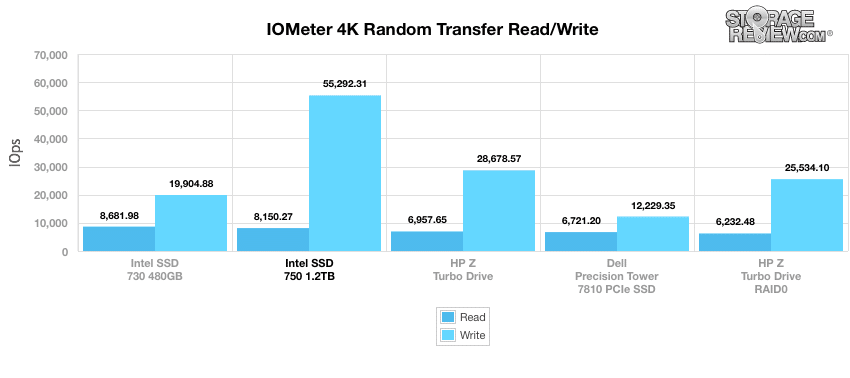
Our 4K write latency tests showed that the 750 had the lowest average latency with 0.0177ms, but fell into the middle of the pack in max latency with 6.482ms.
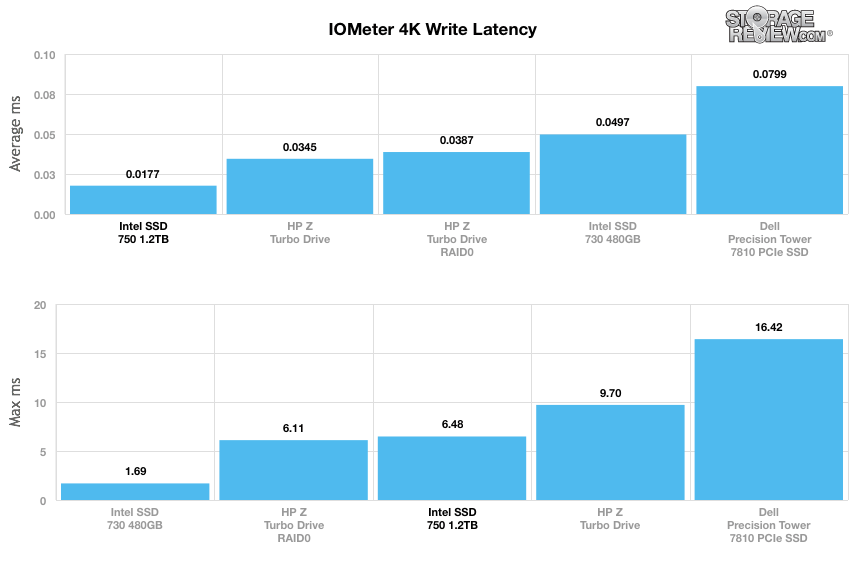
In our next test, we shift to a 4k random workload with 100% write activity that scales from 1QD to 64QD. In this setting the 750 was the top performer, peaking at 169,829 IOPS.
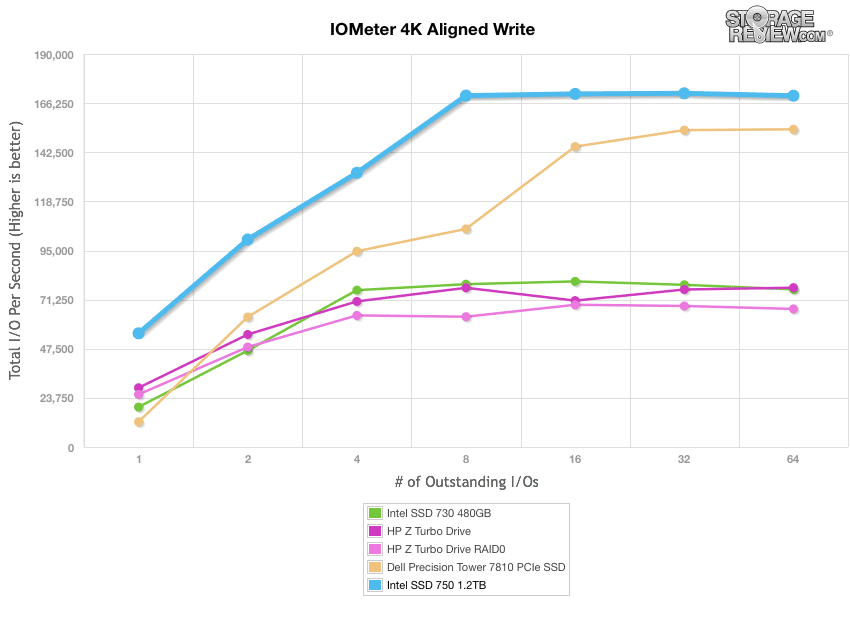
The 750 was a strong performer in 100% read activity, staying in the lead until the higher queue depth where the P3700 took the lead. The 750 peaked at 193,915 IOPS.
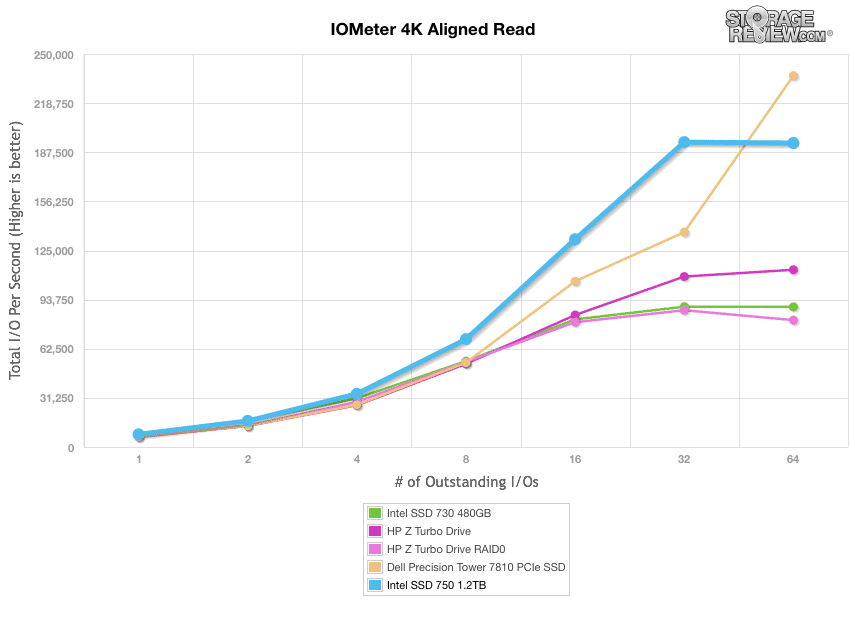
Our last series of synthetic benchmarks compare the hard drives in a series of server mixed-workloads with a queue depth of ranging from 1 to 128. Each of our server profile tests has a strong preference towards read activity, ranging from 67% read with our database profile to 100% read in our web server profile.
The first is our database profile with a 67% read and 33% write workload mix primarily centered on 8K transfer sizes. The 750 handedly outperformed the other drives in this test; with a peak of 153,265 IOPS, the 750 more than tripled the performance of three of the other drives tested (the P3700 was the only other drive that could hold a flame to the 750).
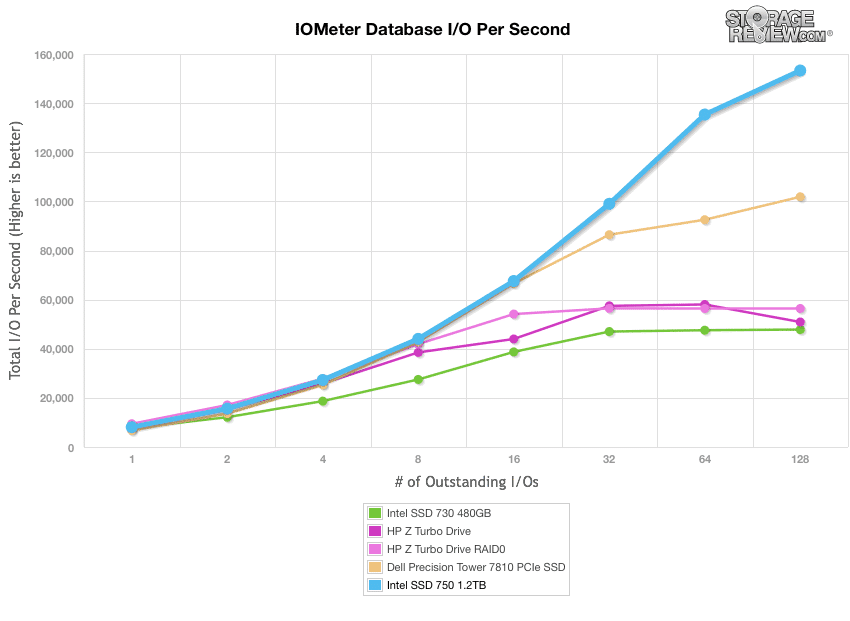
The next profile looks at a file server, with 80% read and 20% write workload spread out over multiple transfer sizes ranging from 512-byte to 64KB. Again we see the 750 dominate, peaking at 122,243 IOPS.
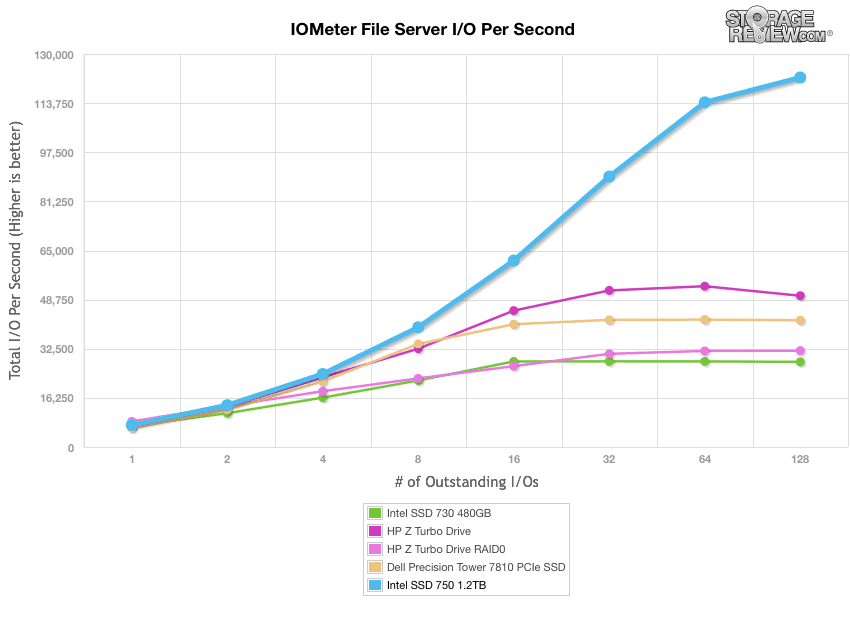
Our web server profile is read-only with a spread of transfer sizes from 512-byte to 512KB. Again we see no real competition as the 750 runs well above the other drives peaking at 134,430 IOPS.
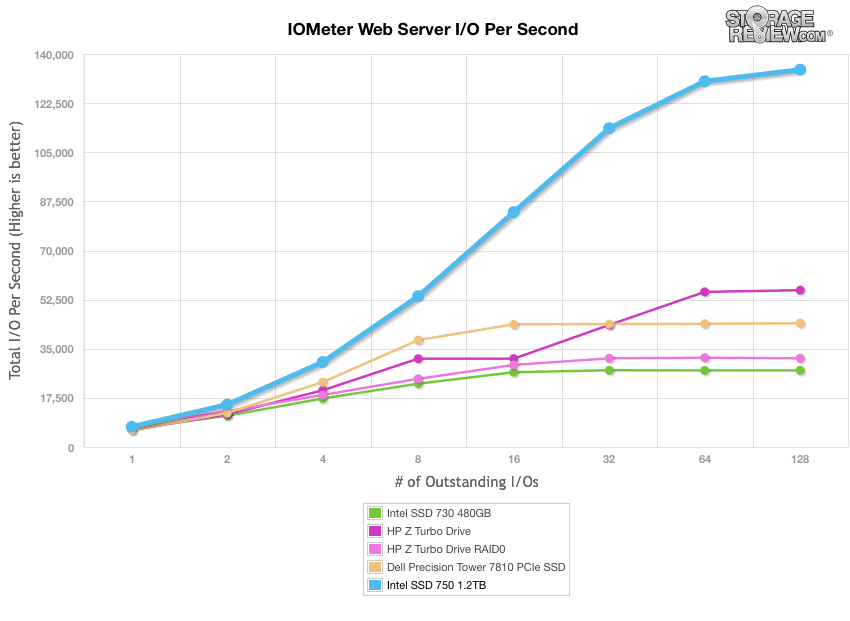
The last profile looks at workstation activity, with a 20% write and 80% read mixture using 8K transfers. Once again we see the 750 dominate the field, however not by as large of a margin.
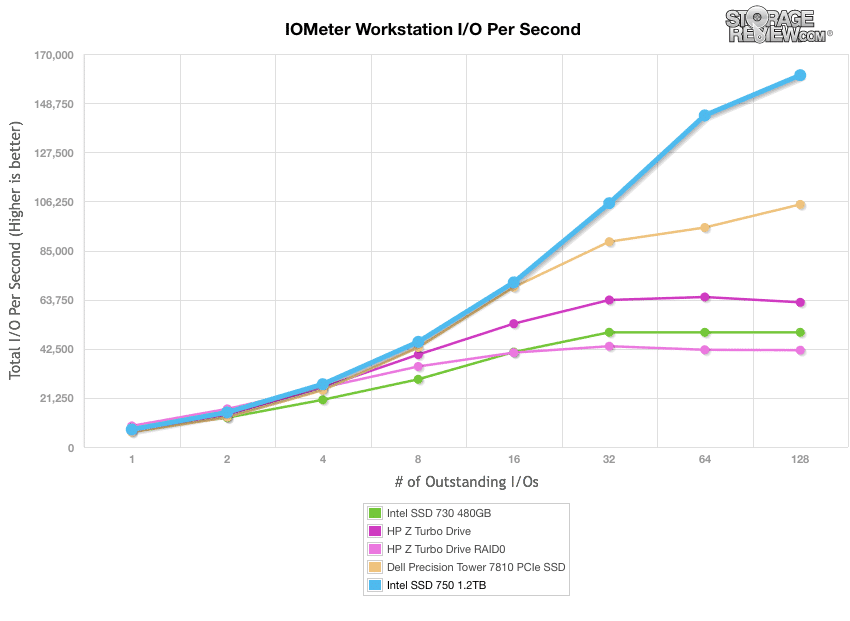
Conclusion
There are a growing amount of people and businesses require ultra-high performance storage solutions that are not limited by SATA interface’s hardware restrictions. It simply can’t keep up with the fast developing flash technology. Equipped with Intel’s 20nm MLC NAND, the 750 Series certainly offers a solution to this problem and avoids these hardware-limitations by taking full advantage of its form factor, as this enthusiast-level SSD uses its PCI Express Gen 3 x4 interface to offer the utmost in performance. This impressive SSD also offers sustained low latency and enhanced power-loss data protection and comes in capacities of 400GB and 1.2TB. Because the Intel 750 also uses NVMe technology, it allows it to boast improved multi-core platform performance, low latency and Quality of Service as well as to minimize idle processor time.
The 750 Series is a very important addition to Intel’s portfolio, which is made obvious through its performance during our extensive benchmarks. When looking at our 2MB sequential and random read benchmarks, the Intel 750 posted a blistering 1,852.97MB/s and 1,668.49MB/s respectively. In comparison to the Intel SSD 730, which is a SATA-based 2.5” drive, it almost quadrupled its speed. When we shifted gears to a 4k random workload with 100% write activity (scaling from 1QD to 64QD), the 750 was the top performer with a peak of 169,829 IOPs. Looking at its 100% read activity, the 750 was again strong performer by staying in the lead until the higher queue depths (peaking at 193,915 IOPS) when the P3700 took over at the very end. The Intel 750 really showed its capabilities when we put it through our server mixed-workloads, taking top spot by a significant margin in all our tested categories. For example, our file server profile (with 80% read and 20% write workload spread out over multiple transfer sizes ranging from 512-byte to 64KB) showed the Intel 750 peaking at 122,243 IOPS, whereas the next highest-performing drive only reached roughly 50,000 IOPS. Our web server profile told a similar start, as the 750 peaked at 134,430 IOPS with no real competition.
Pros
- Incredible performance; fastest client drive (overall) to date
- Reasonably priced
- Power-loss data protection
Cons
- Limited system support for the 2.5” form factor
The Bottom Line
The Intel SSD 750 brings NVMe to client systems in the first meaningful (available) way. The net result is an SSD that is exceedingly fast in both a common PCIe form factor as well as a 2.5″ form factor in systems that support it. For the professional or enthusiast that can take advantage of these speeds and what appears to be pretty reasonable pricing, the SSD 750 is an excellent fit.
Intel SSD 750 at Amazon



 Amazon
Amazon